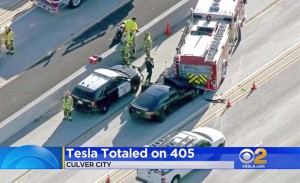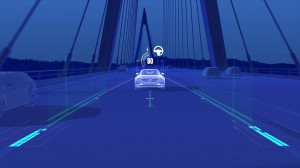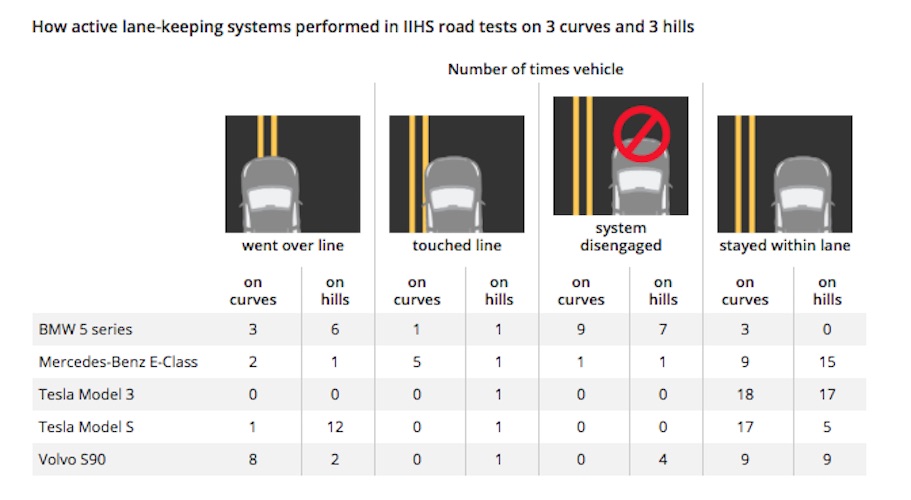Federal safety investigators raced to the scene of a crash involving a Tesla Model S sedan last January after the vehicle slammed into the back of a firetruck stopped on a California highway, regulators wanting to know why that happened despite the vehicle using the carmaker’s advanced driver assistance system specifically designed to prevent such a crash.
“ADAS” systems are being introduced on a wide range of vehicles and, according to industry experts, could substantially reduce the number of crashes, injuries and fatalities on U.S. roads. But a new study by the Insurance Institute for Highway Safety raises serious concerns about the technology. After testing five different systems offered by four automakers, IIHS warns that even though ADAS can prevent some accidents, the technology also could miss some potential problems and, in some situations, actually steer into a crash.
A major concern is that these new, semi-autonomous systems still require drivers to be constantly vigilant, and occasionally intervene, said IIHS chief researcher David Zuby. But that’s often easy to forget. “If the systems seem too capable, then drivers may not give them the attention required to use them safely.”
During the past three decades, automakers have been adding more and more electronic safety gear to their vehicles, starting with the antilock brake systems, or ABS, developed back in the 1980s to help prevent skids. Today, manufacturers are focusing on automated systems that, they claim, eventually will be able to take over driving duties entirely.
While not quite there yet, many of the latest models are being equipped with semi-autonomous systems, such as Blind Spot Detection and Lane Keeping Assist, both of which the IIHS credited with helping reduce crashes, especially low-speed incidents that routinely occur in heavy traffic.
(Magna, Lyft pairing up to develop self-driving technology. Click Here for the story.)
As part of a breakthrough industry-government agreement announced in January 2016, virtually all vehicles are soon to be equipped with even more advanced technology called Automatic Emergency Braking, which can apply a vehicle’s brakes if the driver doesn’t respond to a possible collision. Other new systems are designed to hold a vehicle in its lane or even steer around an obstacle.
But during tests, both on public roads and on track, the IIHS study found that the systems currently offered by BMW, Mercedes-Benz, Tesla and Volvo don’t always work the way they’re intended.
During on-road testing, IIHS engineers found that the BMW, Mercedes and Volvo models all failed to even respond to stopped vehicles under some situations, despite having been rated – along with the Tesla system – as “Superior” in previous IIHS tests. Both Tesla’s Model S and newer Model 3 still hit a balloon used as a target under some circumstances.
Some of the biggest problems involved new systems intended to keep a vehicle centered in their lane. These appear to work well on relatively straight roads, but run into trouble when there are lots of curves and hills. The BMW, Volvo and Tesla Model S, in particular, “steered toward or across the lane line regularly,” the IIHS report noted.
(Click Here to see how high-tech safety gear prevents crashes, but also raises insurance rates.)
Such failures can prove deadly, as highlighted by another crash involving a Tesla Model X in Mountain View, California earlier this year. According to a preliminary report by the National Transportation Safety Board, driver Walter Huang had been relying on the electric SUV’s Autopilot system for nearly 19 minutes when it sounded an alert. But Huang failed to retake manual control and the vehicle slammed into a barrier, hit two other vehicles and caught fire, killing the driver.
The Autopilot system “proved no better at avoiding the same mistakes human drivers might make,” said David Aylor, IIHS director of active safety testing.
That was also demonstrated, according to IIHS, when a prototype autonomous vehicle operated by ride-sharing service Uber hit and killed a pedestrian near Phoenix last March. A preliminary investigation puts some of the blame on the human backup operator in the vehicle who was looking away at the time of the impact and failed to take control and steer away from the pedestrian.
Names, such as Tesla’s Autopilot and Volvo’s Pilot Assist, can complicate the situation, according to Zuby, leading some drivers to assume they can take their hands off the wheel and turn their attention elsewhere.
(More automakers adding life-saving collision warning technology. Click Here for the story.)
While the IIHS report points out that ADAS technology can reduce crashes and limit injuries, the technology also has its limits and, in some cases, serious drawbacks. Automakers routinely advise owners on what the systems can and can’t do in their owners’ manuals, but few drivers actually ever read those manuals and may not realize they have to remain vigilant at all times.



